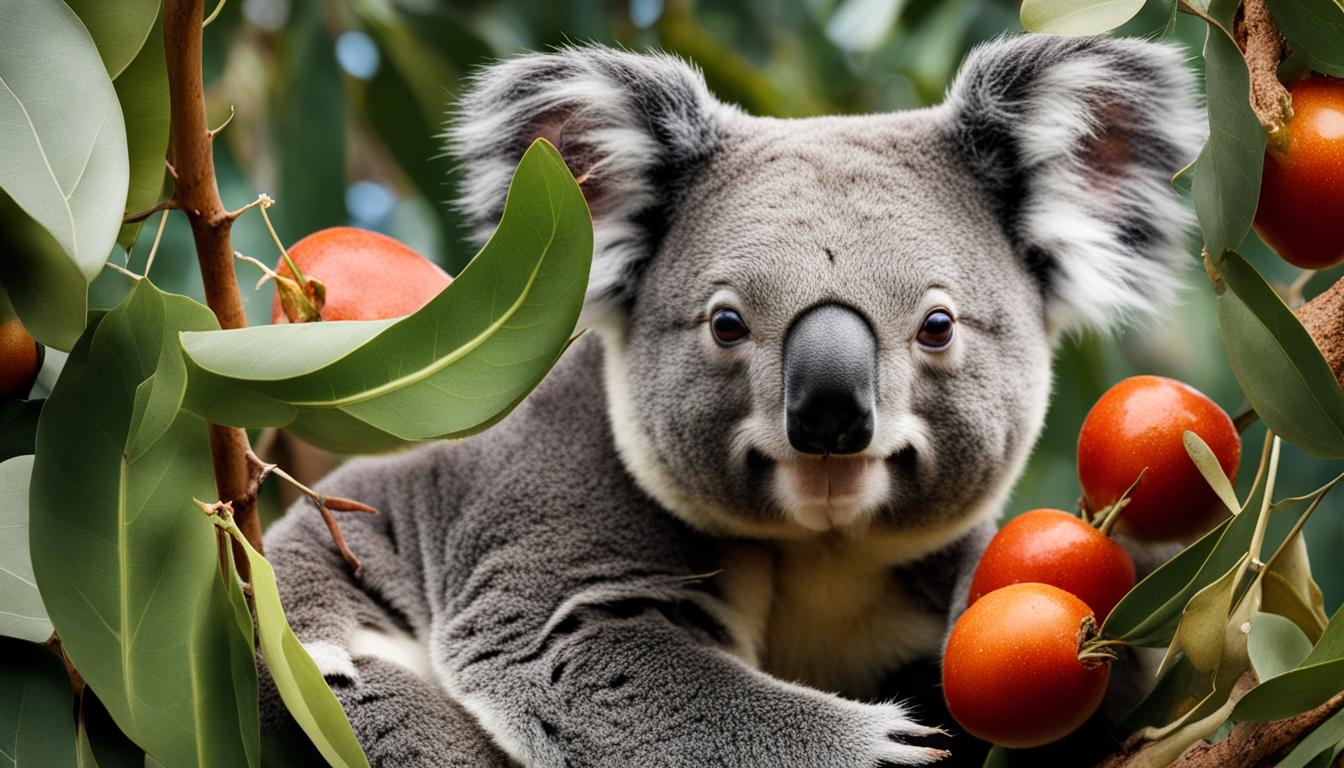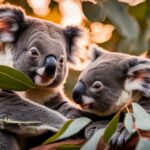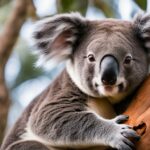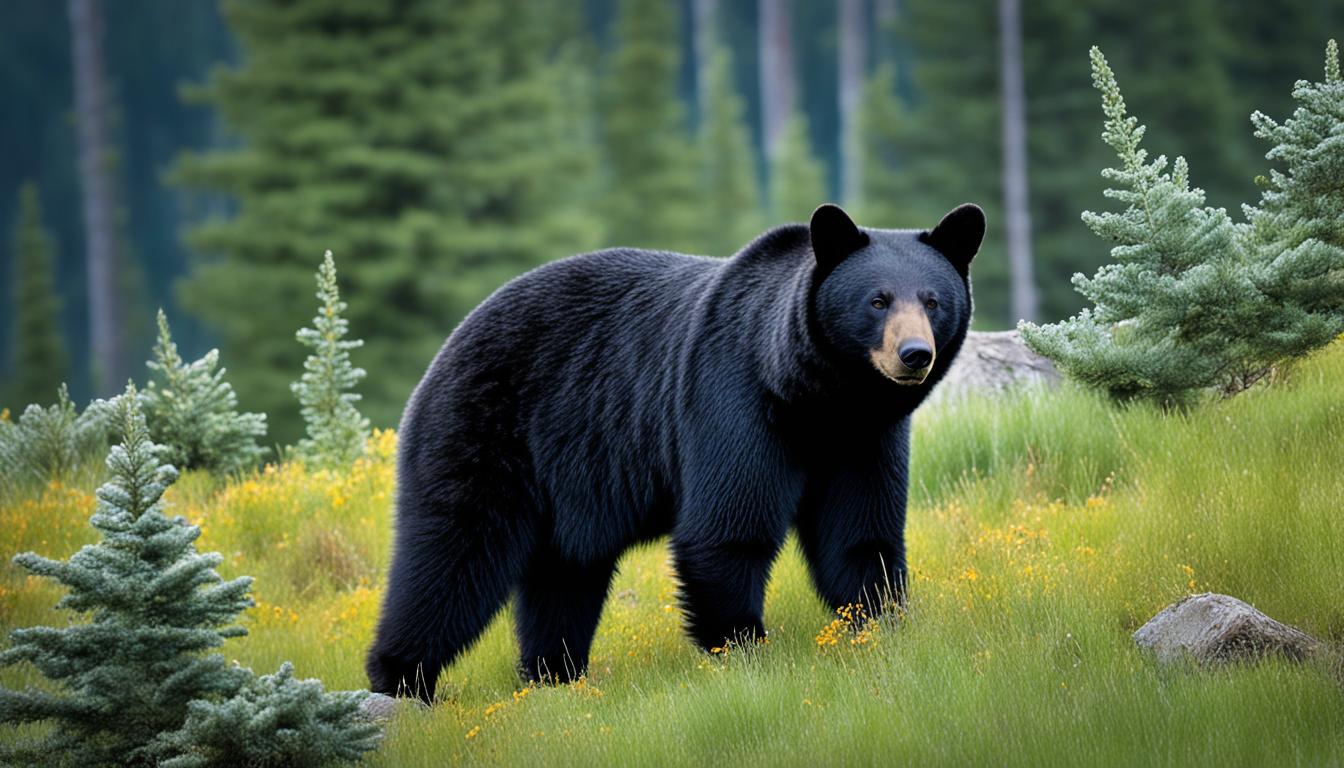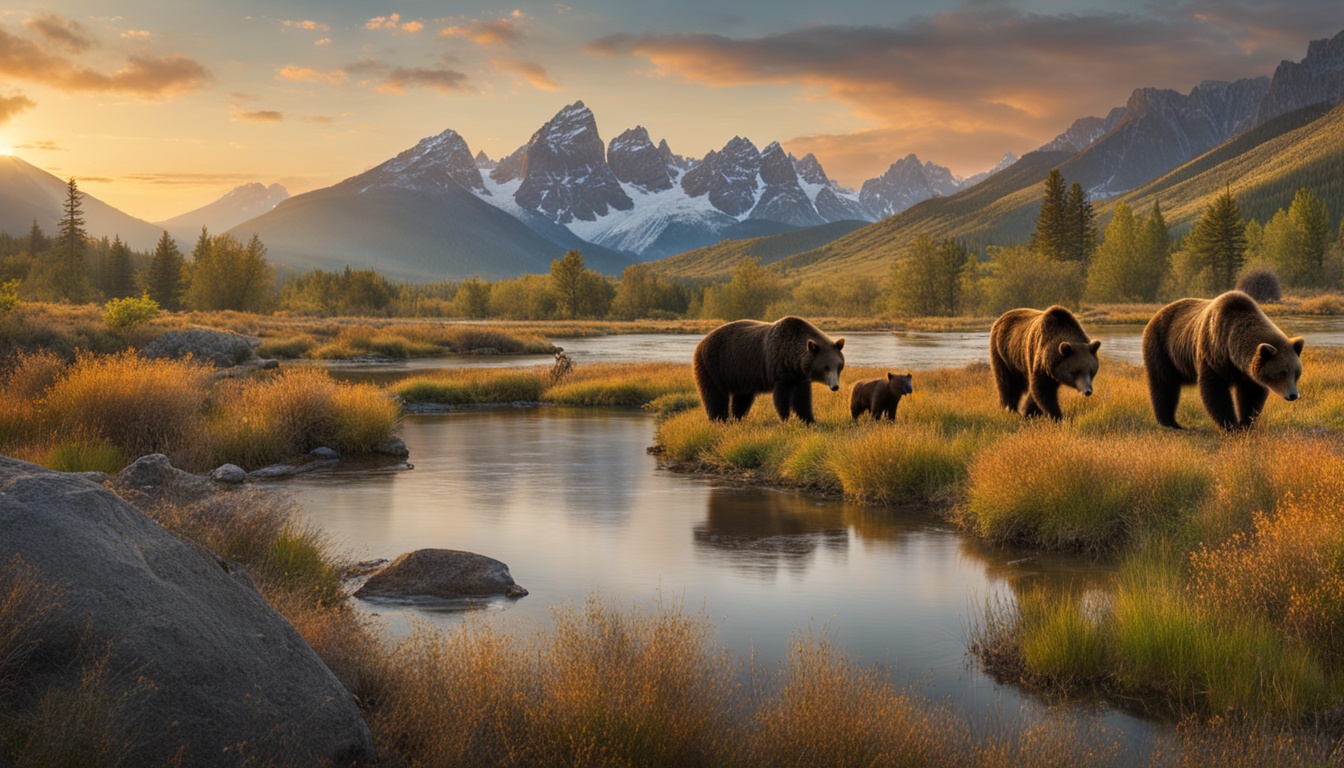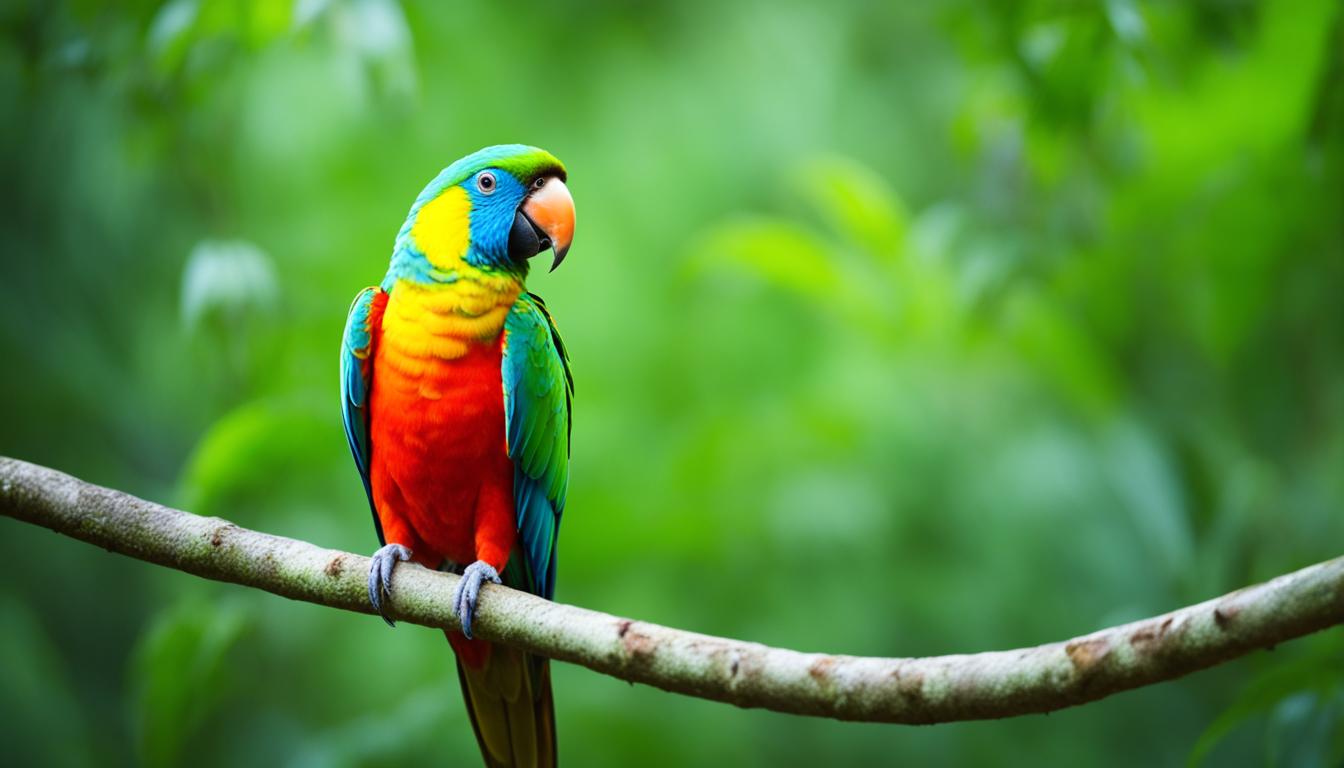Are you curious about the variety in a koala’s diet? While it is well-known that koalas mainly munch on eucalyptus leaves, there is more to their food choices than meets the eye. Let’s explore the diverse diet of these adorable Australian marsupials.
Koalas have a surprising range of food options, beyond just eucalyptus leaves. Although they primarily rely on these iconic leaves, they occasionally snack on leaves from other native Australian trees. This dietary flexibility ensures that koalas can meet their nutritional needs.
What makes the koala’s diet so unique? Well, it all comes down to their specialized digestive system. Koalas have a caecum in their intestine, which contains micro-organisms that aid in the breakdown of fibrous gum leaves. Their teeth are also specially adapted for cutting and grinding leaves, allowing them to consume between 200 to 500 grams of leaves per day.
So, while eucalyptus leaves are crucial for a koala’s diet, their ability to incorporate other food sources showcases their dietary diversity. Stay tuned as we delve deeper into the importance of eucalyptus leaves and the fascinating adaptations that enable koalas to thrive on a gumleaf diet.
The Importance of Eucalyptus Leaves in a Koala’s Diet
Eucalyptus leaves play a crucial role in the diet of koalas, providing them with essential nutrients and hydration. These leaves are not only a source of sustenance but also help koalas meet their hydration needs, reducing their dependency on external water sources. The leaves are low in energy but packed with vital nutrients that koalas have adapted to extract over time. Their specialized digestive system enables them to break down the fibrous leaves and extract the necessary nutrients for their survival.
The unique composition of eucalyptus leaves also presents a challenge for koalas. These leaves contain toxic compounds akin to cyanide, which would be dangerous for most animals. However, koalas have developed specific adaptations to metabolize and process these toxins safely. Their specialized digestive system, including the caecum that houses micro-organisms, facilitates the breakdown of these compounds, allowing koalas to consume eucalyptus leaves without harm.
Eucalyptus leaves make up the majority of a koala’s diet, ensuring that they receive the necessary nutrients for optimal health. While they may consume leaves from other native Australian trees occasionally, eucalyptus remains their preferred choice. The high nutritional value and unique properties of eucalyptus leaves make them essential for maintaining a healthy diet and meeting the nutritional needs of koalas.
Adaptations for a Koala’s Gumleaf Diet
Koalas have several remarkable adaptations that allow them to thrive on a diet primarily composed of gumleaves. These adaptations ensure they can efficiently process and extract nourishment from their fibrous and low-nutrition diet, enabling them to maintain their health and well-being.
One of the key adaptations of koalas is their specialized teeth. They have sharp incisors at the front of their jaws that allow them to nip off leaves from the trees. Additionally, they have strong molars at the back of their jaws for cutting and grinding the leaves into smaller pieces, making them easier to digest. These teeth adaptations enable koalas to effectively process their food and extract the nutrients they need.
Another vital adaptation that supports koalas’ diet is their unique digestive system. Koalas possess a long and broad caecum in their intestine, which houses millions of micro-organisms. These micro-organisms break down the fibrous gumleaves, allowing koalas to absorb the nutrients more effectively. This adaptation is essential because gumleaves are low in nutrition and can be challenging to digest for other animals.
Furthermore, koalas have a highly developed sense of smell, which plays a crucial role in their diet. They can detect the scent of their favorite food trees, primarily eucalyptus trees, from a significant distance. This exceptional sense of smell helps them locate their preferred food sources and ensures they can satisfy their dietary needs even in vast forested areas.
“Koalas’ teeth and digestive system have evolved to meet the specific demands of their gumleaf diet.”
In summary, koalas have evolved remarkable adaptations to thrive on their gumleaf diet. Their specialized teeth, digestive system, and acute sense of smell are all key factors that contribute to their ability to efficiently process and extract nourishment from the fibrous and low-nutrition leaves. These adaptations highlight the incredible resilience and adaptability of koalas in their natural environment, allowing them to maintain their dietary diversity and sustain their health.
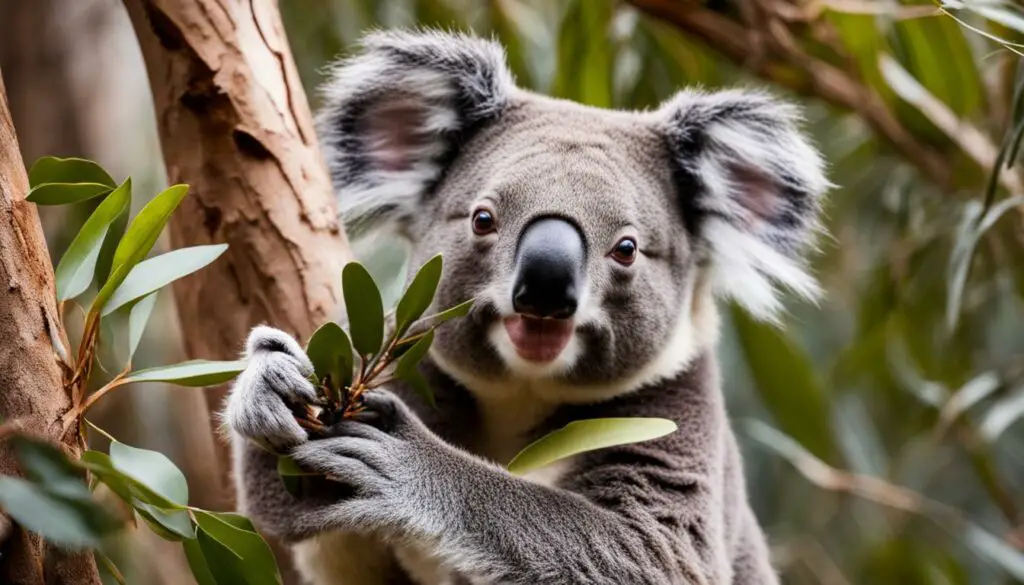
Factors Influencing Koala Diet Variety
Koalas in different areas of Australia have diverse food preferences, leading to variations in their diet. These adorable creatures consume leaves from various types of gum trees, depending on their region. For example, koalas in Victoria may have different food choices than those in Queensland. The availability and abundance of suitable food trees directly impact the feeding habits of koalas, allowing them to maintain a diverse diet.
Table: Koala Diet Variations in Different Australian Regions
| Region | Preferred Gum Trees |
|---|---|
| Victoria | Manna Gum (Eucalyptus viminalis), Blue Gum (Eucalyptus globulus) |
| Queensland | Swamp Mahogany (Eucalyptus robusta), Tallowwood (Eucalyptus microcorys) |
| New South Wales | Forest Red Gum (Eucalyptus tereticornis), Sydney Peppermint (Eucalyptus piperita) |
As shown in the table above, koalas exhibit regional preferences for specific gum tree species. This diversity in food choices allows them to adapt to their local environments and maintain a balanced diet.
However, the loss of suitable habitat due to clearing or habitat destruction poses a significant threat to koalas’ dietary diversity. When their food sources diminish, koalas may resort to overconsuming leaves, leading to the decline of both tree and koala populations. Therefore, it is crucial to ensure the conservation and sustainability of koala habitats to protect their diverse diet and overall well-being.
The Relationship Between Habitat Loss and Koala Diet Variety
Habitat loss and forest clearance have a significant impact on the diet variety of koalas. Koalas rely on specific habitats that provide their favorite food sources, primarily eucalyptus leaves. When forests are cleared or fragmented for human development, koalas lose access to these essential trees, resulting in a scarcity of suitable food options.
As a consequence of habitat loss, koalas may be forced to consume more leaves than the trees can regenerate. This overconsumption leads to a decline in both tree and koala populations. Without access to a diverse range of food sources, koalas’ dietary variety and nutritional intake become compromised.
“Habitat loss and forest clearance directly affect koalas’ ability to maintain a varied and healthy diet.” – Koala Conservation Society
The loss of suitable habitat also disrupts the natural balance of the ecosystem, as it may result in the decline of other plant and animal species that depend on the same habitat. This further exacerbates the challenges faced by koalas in finding diverse food options.
Protecting and preserving koala habitats is crucial for their survival and dietary diversity. Efforts must be made to mitigate habitat loss by implementing sustainable development practices and ensuring the conservation of existing forested areas. By safeguarding their habitat, we can help koalas maintain a healthy and varied diet, contributing to their overall well-being and long-term survival.
The Impact of Habitat Loss on Koalas
Conclusion
In conclusion, the diet of koalas is primarily centered around eucalyptus leaves, but they also incorporate leaves from other native Australian trees into their menu. Their specialized adaptations, including unique teeth and a specialized digestive system, enable them to efficiently extract nutrients from the fibrous and low-nutrition gum leaves. Koalas consume between 200 to 500 grams of leaves per day, ensuring their nutritional needs are met.
However, it’s important to note that the variety of a koala’s diet is influenced by the availability of suitable food trees in their habitat. Different regions in Australia have different types of gum trees, resulting in varied food preferences among koalas. Forest clearance and habitat loss pose significant threats to koalas’ dietary diversity. When forests are cleared or fragmented for human development, koalas lose their food sources, leading to a decline in tree and koala populations.
Protecting and preserving koala habitats is crucial for their survival and the maintenance of a diverse and healthy diet. By ensuring the availability of their favorite food trees, we can support the nutritional choices of koalas and promote a diverse koala diet. Together, we can play a vital role in safeguarding these beloved Australian marsupials and their unique dietary needs.
Do Giant Pandas and Koalas Have Similar Diets?
Giant pandas feeding habits consist mainly of bamboo, consuming up to 26 to 84 pounds per day. On the other hand, koalas’ diet is exclusive to eucalyptus leaves, which they consume in large quantities. While both animals have specialized diets, their feeding habits are not entirely similar.
FAQ
Do koalas eat foods other than eucalyptus leaves?
Yes, koalas occasionally consume leaves from other native Australian trees besides eucalyptus. However, eucalyptus leaves make up the majority of their diet.
What is the importance of eucalyptus leaves in a koala’s diet?
Eucalyptus leaves provide hydration and contain water, reducing the need for koalas to drink. They are low in energy but rich in nutrients that koalas have adapted to extract.
What adaptations do koalas have for their gumleaf diet?
Koalas have specialized teeth for cutting and grinding leaves. They also have a unique digestive system with a caecum containing micro-organisms that aid in breaking down the fibrous gum leaves.
What factors influence koala diet variety?
The availability of suitable food trees in their habitat determines the variety of a koala’s diet. Koalas in different regions of Australia have varied food preferences, consuming leaves from different types of gum trees.
What is the relationship between habitat loss and koala diet variety?
Habitat loss and forest clearance directly impact koalas’ ability to maintain a varied and healthy diet. When forests are cleared, koalas lose their food sources, leading to overconsumption and a decline in tree and koala populations.
Conclusion
Protecting and preserving koala habitats is crucial for the survival and dietary diversity of koalas. Maintaining a balanced ecosystem and ensuring the availability of food sources is essential for their overall health and well-being.

